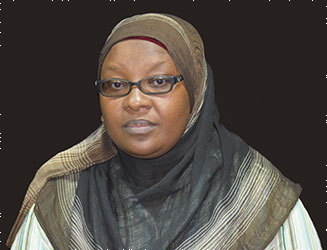Staff Profile

BIO
Khadija I. Mkocha received a BSc, MSc, and PhD degrees in Telecommunications Engineering from the University of Dar es Salaam in 2005, 2009, and 2020, respectively. She is a Graduate Engineer registered by the Engineers Registration Board (ERB), currently pursuing registration as a Professional Engineer. Also, Dr. Khadija is a member of the Institution of Engineers Tanzania (IET) and Institute of Electrical and Electronics Engineers (IEEE), and is a registered Radio Frequency Communications professional by the Tanzania ICT Commission.
Dr. Khadija has been teaching various courses in Electronics and Telecommunications Engineering, including digital, wireless and high frequency communications. In addition, she has taught courses on satellite communications, industrial electronics and automation, and communication fundamentals, including information theory and statistical signal processing.
Her research is mainly on statistical signal processing and its evolution towards artificial intelligence, especially in improving other technologies, such as medical imaging and solar power harvesting. In addition, she has participated and led consultancies on building an innovation ecosystem platform, exploring TV white space for long range communications, and commercialization of research outputs.
Being passionate in enabling youths, she has significantly been involved in innovation support activities for the past 15 years. In her tenure as the college innovation coordinator, she championed the now very successful students-led incubation management. She has published in different areas, including innovation support, traffic engineering, and body area networks.
In her private life, she prefers a “quiet day with a good book and a cup of coffee” kind of atmosphere – although most times she would be baking her days away if not making cold processed body soap bars.
RESEARCH
5G Wireless communication
The 5G network is characterized by two main concepts: Network Function Virtualization (NFV), and Network Slicing (NS). This implies that a 5G network is essentially a software defined network. In this setting, it should be relatively cost effective to set up a test bed where new technologies and use case scenarios can be simulated for idea validation. This research project aims at developing a 5G network testbed with full functionality utilizing the ISM band. Specifically, the research aims
- To establish frequencies to use
- To develop a soft 5G phone (mobile app)
- To develop a 5G New Radio with backward compatibility up to 3G
- To develop 5G core network with NFV and NS capabilities
Satellite communication
There was an initiative to advise the Government towards launching its own satellite. It is a no brainer that launching and subsequently running a satellite system is an extremely expensive undertaking. However, currently there have been some technological advancements in satellite networks and its enabling technologies that could make this feat a possibility. Besides, a locally owned satellite system would be really useful (1) as connectivity alternative during disaster situations, and (2) as an alternative to rural broadband connectivity. It is therefore necessary for a study to be done to assess the most optimal means of establishing a locally owned satellite network in Tanzania by
- Establishing the country baseline on the policies and other regulatory issues on establishing and operating a satellite system
- Conducting a technology readiness assessment for a state-owned satellite network
- Designing the usage case scenarios for the said network
- Development of a cost-effective satellite system for the Tanzanian context
- Conduct knowledge mobilization to inform policy and practice
Multi-sensored medical imaging
Electronic signaling has been almost indispensable in medical practice. Different technologies have always served different purposes resulting into a number of tools such as EEGs, ECGs, MRI scans, Ultrasonograms, X-Ray images etc. However, all these tools work under two main principles: On one hand, there are those that detect electrical activity in the body and assess the presence or absence of disease depending on how the obtained signal varies from what is “normal”. On the other hand, sound/electromagnetic waves have been fired towards the body part of interest and depending on the wavelength of the incident radiation and the reflection/refraction/diffraction properties of the corresponding body tissue, the reflected wave can give a “picture” of the internal condition of the part in question.
Usually, depending on what parameters are of interest to the doctor, a patient may be required to take more than one type of scan at once. For example, anticipating a diagnosis of some problem in the brain, a patient may be required to have both an ECG and an MRI scan. This is due to the fact that one scan may show one physical characteristic better than the other while both are needed for proper diagnosis. This study therefore aims at developing a combined sensing/ combined imaging technology where, for example, a combined ECG / MRI scan can be done and the resulting output can give both the electrical activity as well as snapshots of the brain at once; that is all brain scans at one go. On the other hand, although ultrasonography is relatively safe, it does not give clear pictures of bones since bones absorb sound waves. The aim of this study is therefore
- To establish the safety vs quality image threshold of electromagnetic imaging
- To develop signal processing (estimation/detection) mechanisms to improve ultrasonography imaging of bones and air-filled cavities
- Case study: To develop a combined sensing/ combined imaging brain scanning mechanism
Solar electronics
In generating electricity form solar energy, the highest theoretical efficiency is 86%. Practically, the best converters have managed to obtain a conversion efficiency of up to 50%. This study aims at improving the efficiency of photovoltaic cells through signal processing mechanisms to mitigate post-conversion losses.

